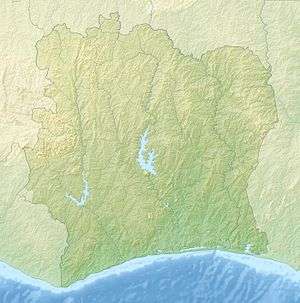Assagny National Park
Assagny National Park or Azagny National Park is a national park in the south of Ivory Coast. It is situated on the coast some 75 km (47 mi) to the west of Abidjan, between the mouth of the Bandama River and the Ébrié Lagoon, and occupies an area of about 17,000 hectares (42,000 acres).[2]
| Assagny National Park | |
|---|---|
IUCN category II (national park) | |
 | |
| Location | Côte d'Ivoire |
| Nearest city | Grand-Lahou |
| Coordinates | 5°12′N 4°53′W |
| Area | 19,400 km² |
| Established | January 1981 |
| Official name | Parc national d'Azagny |
| Designated | 27 February 1996 |
| Reference no. | 790[1] |
Description
Assagny National Park is located in Ivory Coast adjoining the Gulf of Guinea. To the west lies the Bandama River and to the east the Ébrié Lagoon, the park being traversed by the navigable Asagni Canal which connects the two. The park is surrounded by slightly higher ground and consists of a broad, often waterlogged, basin in which the water level fluctuates. The climate here is wet all year round, with an average rainfall of 2,300 mm (91 in). About two thirds of the park consists of swamps dominated by mangroves and there is additionally some moist forest and coastal savanna.[2] The park has potential for tourism.[3]
Flora
The primary forest is dominated by Nauclea diderrichii, Berlinia occidentalis, Strombosia pustulata, Scottellia klaineana, Lovoa trichilioides, Gilbertiodendron preussii, Discoglypremna caloneura, Parinari excelsa, Guarea cedrata, Nesogordonia papaverifera, Erythrophleum ivorense, Tieghemella heckelii, Klainedoxa gabonensis, Lannea welwitschii and Heritiera utilis.[4] The main trees present in the swamps are Rhizophora racemosa and Avicennia germinans, along with many palms including Phoenix reclinata, Borassus aethiopum and Raphia,[2] as well as a variety of swamp vegetation including Echinochloa pyramidalis.[4] The savanna areas are mostly covered with the grass Imperata cylindrica.[2]
Fauna
There are elephants, chimpanzees and many species of monkey in the forests, as well as bushpigs and African forest buffalos. All three species of West African crocodile occur here, Crocodylus niloticus, Crocodylus palustris and Crocodylus cataphractus, but in low numbers and the African manatee occurs in the Ébrié Lagoon.[5] An attempt to increase the number of bay duikers in the park was unsuccessful because of predation by pythons.[3]
The park is an important habitat for wetland birds and was recognized as such when it became a Ramsar site in 2005. Some bird species of note include the cattle egret, the little egret, the grey heron, the black-crowned night heron and the peregrine falcon.[4] BirdLife International recognize the park as being an Important Bird Area.[6]
References
- "Parc national d'Azagny". Ramsar Sites Information Service. Retrieved 25 April 2018.
- "Parc national d'Azagny". United Nations Environment Programme. 1983. Retrieved 2 June 2019.
- East, Rod (1990). Antelopes: Global Survey and Regional Action Plans. IUCN. pp. 51–58. ISBN 978-2-8317-0016-8.
- "Côte d'Ivoire: Parc national d'Azagny" (PDF). Fiche descriptive Ramsar (in French). Ramsar. 18 September 2018. Retrieved 2 June 2019.
- Stuart, Simon N.; Adams, Richard J.; Jenkins, Martin (1990). Biodiversity in Sub-Saharan Africa and Its Islands: Conservation, Management, and Sustainable Use. IUCN. pp. 108–110. ISBN 978-2-8317-0021-2.
- Fishpool, Lincoln. "Côte d'Ivoire" (PDF). BirdLife International. Retrieved 2 June 2019.
